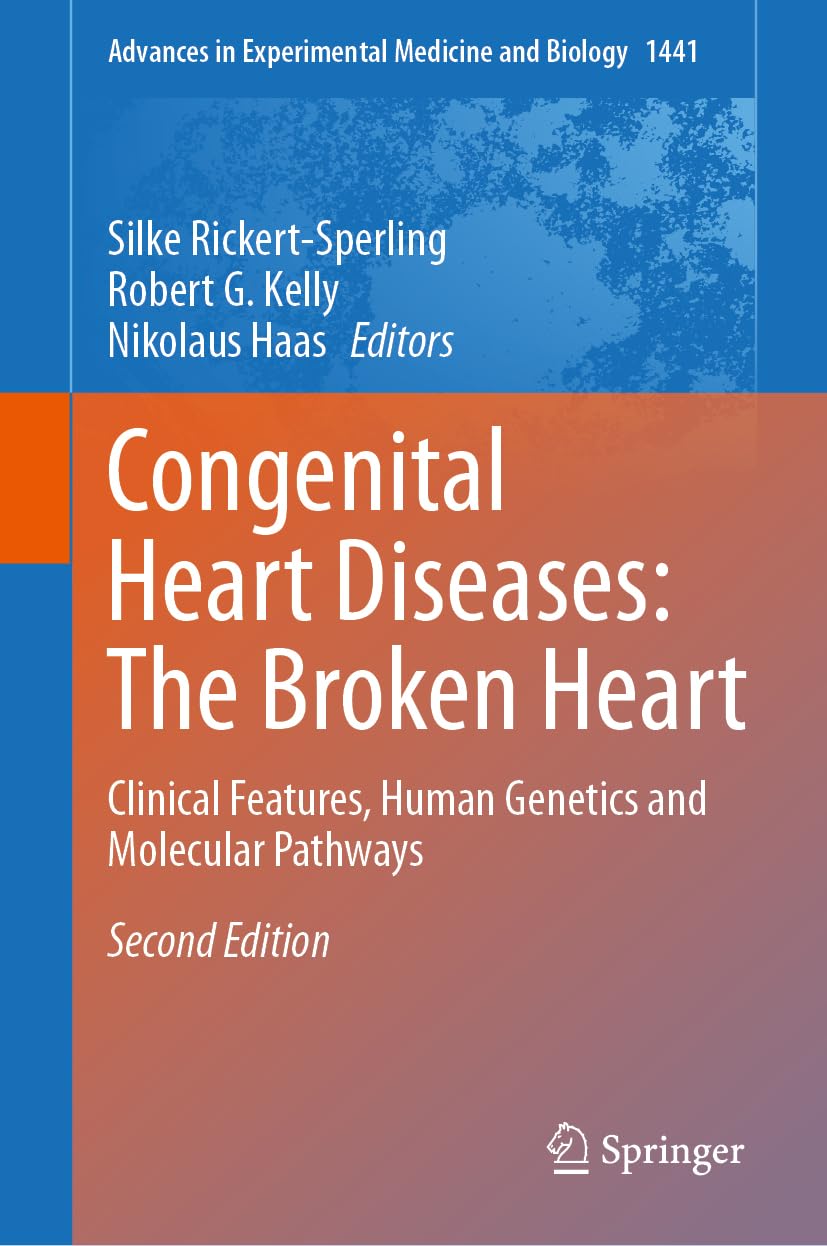This 2nd edition has been extensively updated and provides comprehensive and current insight into congenital heart diseases, from embryonic development through to clinical features, including human genetics and our current knowledge of the underlying molecular pathways.
The book is divided into three parts: an introduction to the development of the heart and its vessels, an overview of the molecular pathways affecting the development of various cardiovascular structures, and a main section focusing on the different types of structural and nonstructural congenital heart diseases, including their clinical features, underlying genetic alterations and insights from animal models and pathways.
All chapters have been updated and new chapters added on state-of-the-art approaches including stem cells and organoids, cardiac metabolism, single cell transcriptomics and 3D reconstruction of human heart development.
The clinical chapters have been extended and include new sections on diagnostic imaging techniques.
Taken together, the book, written by and for clinicians and researchers, provides an integrated and up-to-date resource for all those who want to learn more about both the clinical aspects and the genetic and molecular basis of congenital heart disease.
Part I. Introduction
01. Human Cardiac Development
02. Human Genetics of Congenital Heart Defects
03. Cardiac Development and Animal Models of Congenital Heart Defects
04. Normal Cardiac Anatomy and Clinical Evaluation
Part II. Development of the Heart and Its Vessels
05. Cardiac Progenitor Cells of the First and Second Heart Fields
06. Neural Crest
07. Inflow Tract Development
08. Epicardium and Coronary Vessels
09. Establishment of Cardiac Laterality
10. Development of the Cardiac Conduction System
11. Hemodynamics During Development and Postnatal Life
12. Evolutionary Aspects of Chamber Formation and Septation
13. Deciphering Congenital Heart Disease Using Human Induced Pluripotent Stem Cells
14. Cardiac Development at a Single-Cell Resolution
Part III. Central Molecular and Cellular Pathways
15. Inter- and Intracellular Signaling Pathways
16. Cardiac Transcription Factors and Regulatory Networks
17. Posttranscriptional Regulation by Proteins and Noncoding RNAs
18. Epigenetics
19. Cardiac Metabolism
20. Environmental Signals
21. The Contractile Machines of the Heart
22. Technologies to Study Genetics and Molecular Pathways
Part IV. Atrial Septal Defect
23. Clinical Presentation and Therapy of Atrial Septal Defect
24. Human Genetics of Atrial Septal Defect
25. Molecular Pathways and Animal Models of Atrial Septal Defect
Part V. Ventricular Septal Defect
26. Clinical Presentation and Therapy of Ventricular Septal Defect
27. Human Genetics of Ventricular Septal Defect
28. Ventricular Septal Defects: Molecular Pathways and Animal Models
Part VI. Atrioventricular Septal Defect
29. Clinical Presentation and Therapy of Atrioventricular Septal Defect
30. Human Genetics of Atrioventricular Septal Defect
31. Molecular Pathways and Animal Models of Atrioventricular Septal Defect
Part VII. Total Anomalous Pulmonary Venous Return
32. Clinical Presentation and Therapy of Total Anomalous Pulmonary Venous Return
33. Total Anomalous Pulmonary Venous Connections, Human Genetics
34. TAPVR: Molecular Pathways and Animal Models
Part VIII. Tetralogy of Fallot and Double Outlet Right Ventricle
35. Clinical Presentation and Therapy of Tetralogy of Fallot and Double-Outlet Right Ventricle
36. Human Genetics of Tetralogy of Fallot and Double-Outlet Right Ventricle
37. Molecular Pathways and Animal Models of Tetralogy of Fallot and Double Outlet Right Ventricle
Part IX. d-Transposition of the Great Arteries
38. Clinical Presentation and Therapy of d-Transposition of the Great Arteries
39. Human Genetics of d-Transposition of Great Arteries
40. Molecular Pathways and Animal Models of d-Transposition of the Great Arteries
Part X. Defects of Situs
41. Clinical Presentation and Therapy of Anomalies of the Situs
42. Human Genetics of Defects of Situs
43. Molecular Pathways and Animal Models of Defects in Situs
Part XI. Semilunar Valve and Aortic Arch Anomalies
44. Clinical Presentation and Therapy of Semilunar Valve and Aortic Arch Anomalies
45. Human Genetics of Semilunar Valve and Aortic Arch Anomalies
46. Molecular Pathways and Animal Models of Semilunar Valve and Aortic Arch Anomalies
Part XII. Coronary Artery Anomalies
47. Clinical Presentation and Therapy of Coronary Artery Anomalies
48. The Genetics of Human Congenital Coronary Vascular Anomalies
49. Congenital Coronary Blood Vessel Anomalies: Animal Models and the Integration of Developmental Mechanisms
Part XIII. Truncus Arteriosus
50. Clinical Presentation and Therapy of Truncus Arteriosus
51. Human Genetics of Truncus Arteriosus
52. Molecular Pathways and Animal Models of Truncus Arteriosus
Part XIV. Tricuspid Atresia and Univentricular Heart
53. Clinical Presentation and Therapy of Tricuspid Atresia and Univentricular Heart
54. Human Genetics of Tricuspid Atresia and Univentricular Heart
55. Molecular Pathways and Animal Models of Tricuspid Atresia and Univentricular Heart
Part XV. Ebstein Anomaly
56. Clinical Presentation and Therapy of Ebstein Anomaly
57. Human Genetics of Ebstein Anomaly
58. Molecular Pathways and Animal Models of Ebstein’s Anomaly
Part XVI. Hypoplastic Left Heart Syndrome
59. Clinical Presentation and Therapy of Hypoplastic Left Heart Syndrome
60. Human Genetics of Hypoplastic Left Heart Syndrome
61. Molecular Pathways and Animal Models of Hypoplastic Left Heart Syndrome
Part XVII. Cardiomyopathies
62. Clinical Presentation and Therapy of Cardiomyopathies
63. Human Genetics of Cardiomyopathies
64. Molecular Pathways and Animal Models of Cardiomyopathies
Part XVIII. Arrhythmias
65. Clinical Presentation and Therapy of Arrhythmias
66. Human Genetics of Cardiac Arrhythmias
67. Molecular Pathways and Animal Models of Arrhythmias
Back Matter


